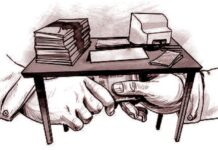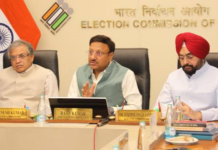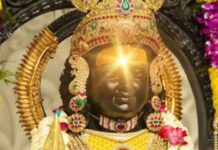Badadanda (Grand Road) was not a continuous stretch as it was bisected by an intervening river Malini. There was then a need of constructing two sets of three Chariots. This hurdle was overcome by 1275 A.D. during the rule of Bhanudev-I, who diverted the course of the Malini river and the Grand Road became a long continuous stretch, whereupon only three chariots were engaged.
The temple of Lord Jagannath on the Bay of Bengal at Puri in the State of Odisha is a monumental edifice which is visited by thousands of pilgrims everyday and near about a million on special festive occasions, e.g., the Snana Yatra (Celestial bathing of the Deities on the day of Jyestha Purnima), Rath Yatra (Asadha Shukla Dwitiya) and Navakalevara (at an interval of seven to twelve years in an intercalary month of Asadha as would be ascertained from the almanac).
Puri town city is a sea-resort city. The census of 2011 puts the population figure at two lakh five hundred sixty four of which one lakh four thousand as male and about 96,500 as female. Here, Hinduism is the majority religion scoring nearly 98%. Christiaity, the second most popular religion is 1.07%, Islam 0.75%, Jainism 0.01%, Sikhism and Buddhism scoring 0.02% respectively. In ancient times Puri was known as Purusottama, later Srikshetra & Nilachal. Some scholars try to associate the name Puri with Pura of the Bali Island and Prom of Burmese Shrikshetra. Ananga Bhima Dev III (1211-42) of the Ganga dynasty called his empire as Purusattoma Samrajya and he declared himself as the Rout or viceroy of Lord Jagannath, echoing the royal declaration of Summerian kings where the King was a bailiff of the presiding State Deity by 2000 B.C. Hittites in Asia Minor who used a kind of old Sanskrit as their lingua franca had named two of their city states as Purusa Khanda and Purusaddum. Hittites in Asia Minor were traders who annually visited Odisha Ports between 1900-1800 BC for import of sandal wood, camphor, myrrh, resin etc which were plentily available in Chandanpur and Karpura- Harichandan areas in Puri district. Scholars like Ashutosh Parasad Patnaik (Ref. Mahadevata, 2010) have discovered trade route from Asia Minor to Puri. According to them Puri then was a very prosperous trade centre with a number of ports in the adjoining sea coast. The then Assyrians and Hittites of Asia Minor were worshippers of Indra and Varuna. Earlier, the Assyrians probably had built a three-layer pyramid where they had installed their State-deity Jigurat in Puri sea–coast which was later abandoned by the Hittites who reinstalled their deities Indra and Varuna in an area (from the present Gundicha temple to Chakratirtha). This demarcated area was probably Purusaddum (or Purastama) as surmised by A P Patnaik in his Mahadevata book. Besides, the Sanskrit Palm-leaf Vishnudharma now preserved in Asiatic Society of Bengal MS No.1670) has a reference to Purusottama who was worshipped in Puri during the 2nd-3rd Century A.D, much before any temple was built there.
Nila-Madhav, Adi Nrusingha, Savari Narayan, the Buddha, Purusottama, Maha Bhairava, Niladrinatha, Jagaboi, Jigurat, Jagannath, Ganesha, Sri Rama, Sri Krushna, Sri Vishnu, Vasudeva, Vamana, Nirakara Param Brahma, Sunyadehi, Dadhi Vaman and Daru Brahma are a host of epithets or synonyms of Lord Jagannath, the most endearing humanised Lord of the Universe, the summum bonum of Odia nation, nay, of the cosmopolitan believers who affirm the omnipresence of the Divine. On the psyche of devotees and pilgrims Lord Jagannath is irresistibly omnibenevolent. The Lord has manifested, Himself in his chosen Form in Sri Kshetra-Puri on a sandhill only to oversee the mankind and extend His grace to them who treasure faith as the driving force in life. Sanskrit texts, Odia poets ( from the 15th Century till date), devotees irrespective of caste and diverse races, saints, philosophers, mystics and advocates of Pan-Indian religious schools have paid their glowing tribute to Lord Jagannath and these are still on record.
In the sanctum sanctorum on the bejewelled throne (Ratna Simhasana) are majestically placed the images of Lord Jagannath, Devi Subhadra and Lord Balarama. On the left of Lord Jagannath is placed Lord Sudarshan in the form of a sacred staff. These four deities are combinedly regarded as Chaturdha Murtti. They are all made of sacred wood. On the Ratna Simhasana, three more deities are also placed. They are Madhav (made of Wood), Bhu Devi (Earth goddess or Saraswati, metalic body) and Shri Devi (Lakshmi in metalic body). Nearly 120 categories of servitors are engaged in executing daily 22 rituals of the deities right from the dawn till the midnight. The deities are gorgeously dressed and decorated. They change their dress four times a day except their special dress before retiring to bed. On week days, the colour of their dress also changes. On Sunday they wear red silk, Monday white silk spotted with black, on Tuesday multi-coloured silk, on Thursday Yellow silk, on Friday white silk and on Saturday they wear dark silk besides floral decorations. The deities are offered breakfast, early luch (Sakala dhupa) Mid-day Launch (Madhyahna dhupa), in the evening Sandhya dhupa and Bada Simhara dhupa ( dinner ) which reflect a culinary triumph of Odias. A plethora of confectionary, plain and sophisticated rice and dishes are prepared very hygienically in the Lord’s kitchen by skilled Chefs and a host of cooking experts for daily offering to the Lord. The offered food stuff is most consecrated and is known as sacred Mahaprasada. Shri Mahaprasada is enthusiastically and devotedly sought by the devotes round the year. The divine kitchen has the competence of catering to the demand of more than ten thousand seekers of the holy Mahaprasada each day.

The Lord lets loose his sporting spree round the year. Thirteen major festivals are celebrated in twelve months of a year. The important festivals are Jhulana (Swinging), Chandan Jatra, Snana Jatra and Ratha Jatra. In Snana Jatra ( outdoor celestial bathing on Jyestha Purnima ) and Ratha Jatra ( the Car or Chariot festival in the month of Asadha, particularly on the second lunar day of the bright fortnight), the Deities come out of the santum sanctorum ( or garbhagruha) and pose for public darshan. In none of the Hindu temples of India the presiding deity leaves His hallowed seat for any festive occasion whatsoever.
Ratha Jatra
Reference to Ratha is found in the Vedas, Puranas, Buddhist fairs (Fahien’s travelogue: at Khotan and at Pataliputra). The car festival is stated to have been observed by the Jains, Saivites and followers of Surya cult (the Konark temple is in the shape of a chariot). Mention has already been made how in 1800 B.C the Assyrians and Hittites in Asia Minor were employing armed chariots in the warfare. Similarly, the Car Festival was also observed in Sicily (Italy). There a colossal Car drawn by buffaloes was used to be dragged through the ill-paved streets carrying a variety of erected objects like the Sun and the Moon on a specific day of the year.
The Car Festival or the Chariot Festival in Puri was in vogue in the 12th Century. The Sanskrit play, Anargha Raghava by Murari Mishra (10th-11th Century) refers to the Yatra of Purusottama which may refer to Ratha Jatra. A 13th-14th sculptural representation of Ratha Jatra (now displayed in the State Museum) vouches for the prevalence of the chariot festival. In the 14th Century Friar Odoric (see Hobson Jobson), the Sirat-i-Firuz Shahi by an anonymous Muslim chronicle (14th Century), Abul-Fazal (the historian of the Court of Akbar) , travelers like Mahamud-bin Amirwali ( in 1626), W. Bruton (1633), Sebastian Manrique (1636), Burnier (1667), Thomas Bowrey (1669-79), Alexander Hamilton (1727), Robert Sathe (1809), Harcourt (1805), Andrew Stirling (1825), James Fergusson (1837) have given both their distorted and faithful account of Ratha Jatra in Puri. The-then missionaries deliberately undermined the colourful pageant of the Chariot Festival by referring to the cars as ‘monstrous’ ‘horrors of the festival’. In some of the alien accounts, the sacred chariot Nandighosa of Lord Jagannath appeared ‘awful Juggernaut’ which became a standing metaphor for ‘any relentless destroying force or object of devotion & sacrifice’ by their fellow travelers and officers of the East India Company.
Construction of three Chariots/Cars
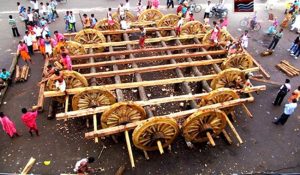
The Ratha Jatra is otherwise known as ‘Ghosa Jatra’ or Patitapavana Jatra or Dasavatara Jatra or Navadina Jatra or most conspicuously Gundicha Jatra as the three chariots leave the front-yard of the Temple (in front of the Lions Gate) and are drawn one after the other by a concourse of devotees till these reach their destination at the front-yard of the Gundicha Temple in the north, thus covering a distance of nearly 3 Kms. Hence, it is called Gundicha Jatra. The Gundicha Temple seemed to have been constructed by the founder of the Ganga dynasty, Anantavarma Chodagangadev in honour of his Queen Gondabada sometime in the first decade of the 13th Century. The Grand Road running from the Lions Gate to the Gundicha Temple was then not a continuous stretch as it was bisected by an intervening river Malini. There was then a need of constructing another set of three Chariots which would be parking on the other side of the river. However, this hurdle was overcome by 1275 A.D. during the rule of Bhanudev I, who diverted the course of the Malini river and the Grand Road became a long continuous stretch, whereupon only three chariots were engaged. The importance of Ratha Jatra and details thereof are well described in Brahma Purana, Narada Purana, Skanda Purana, Niladri Mahodaya, Padma Purana and Bamadeva Samhita etc. The joyous ride of the Deities is enthusiastically highlighted in Vasantotsava Kavyam of Haladhara Mishra (17th C), Gundicha Champu of Vakravak Chakrapani Pattanayak, Gundichotsava Varnanam by Bhagavata Brahma and Gundicha Vije by Brajanath Badajena, Basudev Rath in his Gangavamsanucharitam ( 18th C) has also given an interesting account of the Car festival. The Chariots are constructed according to the Silpashastra manual, mainly Manasara, Aparajita Puchha, Silpasara Sangraha etc. Collection of appropriate and required number of timber and their phasewise construction by initiated carpenters follow a strict procedure as per the temple amanac. Important days are Sri Panchami, SriRama Navami, Akshaya Trutiya, Nrusingha Chaturdash, SriKshetra Bhaunri, Devasnana Purnima and Netrotsava ( on the eve of the Car Festival).Construction of the Chariots, continues in full swing in the temporary timberyard in front of the King’s palace on the Grand Road. The carpenters, otherwise known as Visvakarmas observe austerity and sanctity during the 55-56 day long chariot construction. More than 190 sevayat-workers including Maharana, Bhoi, Kamara, Chitrakara, Darajee and Rupakaras are engaged. According to Ratha Samhita nearly 1139 pieces of logs of wood are required for construction of three chariots which bear three separate names e.g. Nandighosa Ratha of Lord Jagannath), Taladhvaja Ratha ( of Lord Balabhadra) and Darpadalana ( of Devi Subhadra). The Chariots have an attachment of four wooden horses, one charioteer and two wooden parrots each. Each Rath contains nine subsidiary deities.
Taladhvaja or Haladhvaja Ratha of Balabhadra is of 45’ height and it moves on 14 wooden wheels. The three sides of Ratha are wrapped (called mandani) in red and blue coloured shining cloth. It is placed on the extreme east in front of the Simhadvara. 731 pieces of wood of different sizes are used in Taladhvaja. The wooden horses are painted black. Darpadalana or Padmadhvaja Ratha of Devi Subhadra is of 44’6” height which rests on 12 wheels. 711 pieces of wood of various sizes are used in constructing Darpadalana Ratha. It is wrapped in black and red cloth. The wooden houses are painted red.
Nandighosa or Garudadhvaja Ratha of Lord Jagannatha is of 45”6” height and has 16 wheels. 742 pieces of wood are utilized in construction of Nandighosa. The four wooden horses are painted shiny white. Three sides of Nandighosa are wrapped in Yellow and red cloth.
Lord Balabhadra is accompanied by the images of Rama and Krushna on his Taladhvaja, Devi Subhadra is accompanied by Sri Sudarshana whereas Sri Madanamohana gives company to Lord Jagannath in his Nandighosa Ratha.
Those who opine the Ratha Jatra as Vijay Utsava or Kalyana Utava refer to Jagannatha-Krushna’s marriage ritual. Four days prior to the Snana Purnima on the 11th lunar day of the bright fortnight of Jyestha, Krushna was to marry Rukmini in a strategy of the latter’s elopement, but the union could not be consumated as the Lord fell ill soon after his lavish bath on the Jestha Purnima. Goddess Lakshmi in the guise of Rukmuni had to spend many a sleepless night for her reunion. But Lord Krushna-Jagannath had to tarry on the plea of his feigned illness for about fifteen days and remains confined to the sequestered Anasara Gruha. Even after his recovery and gain of flamboyant youthfulness, He forgets the marriage paraphernalia, joins the Pahandi procession and quickly rides his chariot Nandighosa which is awaiting him in front of the Lions Gate. The irresistible anxiety coupled with joyous exuberance of the world of devotees congregated on the Grand Road and the heavenly denizens above moved Lord Jagannath very deep. Being majestically dressed and decorated He rides away to His Birth place, the Gundicha Temple in the company of his elder brother Balabhadra and sister Subhadra. There on the Adapa Mandapa He distributes His grace to all and sundry during his week-long sojourn. Ma Lakshmi feels quite exasperating in the contrived absence of her consort. She rushes to the Gundicha temple on the 5th day (Hera Panchami), meets the Lord and gets his assurance of early return to Sri Mandira and then she comes back while hurting the Nandigosa chariot as a token of deep-felt anguish. On the 9th day of the commencement of Ratha Jatra, the Lord heralds His pompous return journey (Bahuda Jatra). When Nandighosa reaches the frontyard of Raja’s palace, Ma Laksmi goes to chahani mandap and becomes aware of His return. She moves to the palace frontyard riding her palinki. Gajapati Maharaja would be waiting for Her. He helps Ma Lakshmi for Her meeting with Lord Jagannath. It is known as Lakshmi-Narayana Bheta. She comes back to the temple and Nandighosa is then pulled to the frontage of the Lions Gate.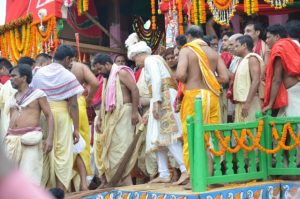
It may be mentioned here that one of the very exciting and important events during the Car Festivals is the Chhera pamhara ceremony which is conducted by the First and Prime Servitor (Prathama Sevak), the Gajapati Maharaja of Puri. He ceremonially cleanses the platform of the three chariots, Taladhvaja,, Nandighosa and Darpadalana before commencement of Their jolly ride. Gajapati also repeats this service during the Bahuda Jatra.
The Maths (monasteries) in Puri render valuable service during the Ratha Jatra Festival. Most important among them are Raghava Dash Math, Govarddhana Math, Shankarananda Math, Jagannath Ballabha Math, Jatia Babaji Math, Bada Odia Math, Chhauni Math, Mahiprakash Math, Dakshina Parshva Sri Ram Das Math, Emar Math,Newal Das Math and Gangamata Math. Besides these, thirteen other Maths also provide panti bhog (uncooked food stuff) during the Gundicha Jatra, Adapa Vije, Hera Panchami, Bahuda Jatra and Niladri Vije.No cooked food is offered to the deities while they are aboard the chariots except confectionary. During Lord’s sojourn in the Gundicha temple, the Sandhya darshan ( on the 8th day evening) attracts a huge audience. On the 6th day of Gundicha journey, the chariots take an about-turn and they face the south, in the direction of Sri Mandira. This event is known as Dakshina Moda.

The concluding events of Ratha Jatra are the Suna Besa (or wearing heavy gold ornaments ) of the Deities while they are aboard their respective chariots on the lunar 11th day of the bright fortnight of Asadha. The day following is also equally eventful. The event is known as Adhara Pana. Massive earthen vessels containing sweet-scented drinks are offered to the Deities while they are aboard Their respective chariots. The valedictory event is known as Niladri Vije which takes place in the late evening. Images of Madanamohana, Rama and Krushna are first ceremonially taken back for reinstallation in the Dakshina Ghara ( South-Chamber). Then the Pahandi procession starts. Sri Sudarshan, Sri Balabhadra and Devi Subhadra join the Pahandi one after the other and are installed on the Ratna Simhasana. Lord Jagannath now remembers His breach of assurance given to Ma Lakshmi. He tarries and apprehends some trouble might assail Him engineered by Ma Lakshmi. His apprehension comes true. He is disallowed entry by the servitors of Ma Lakshmi. Apprehending the trouble, He has already brought with Him a pot of sweet rasagola to sweeten ensuing bitterness. In fact, after an hour-long wit repartee, the Lord becomes successful in winning back favour of His consort. Then the Lord victoriously repairs to his bejewelled throne almost after a gap of 27-28 days. There he meets Madhava (wooden image of tiny Jagannath of 18” height) who was in charge of Sri Mandira during the absence of Lord Jagannath. Peace and tranquility and blissful atmosphere now prevail everywhere.










